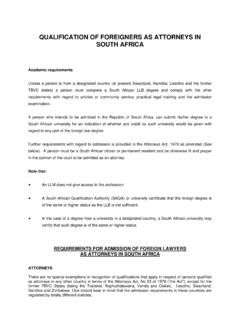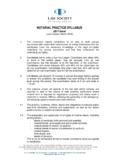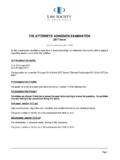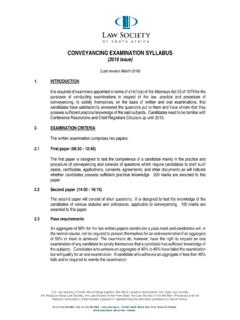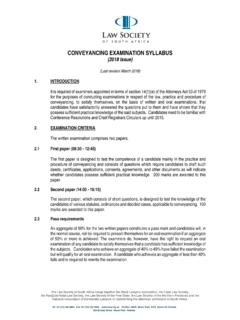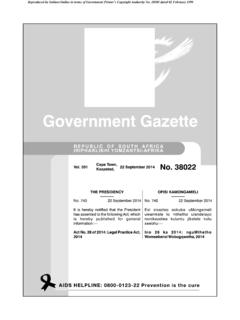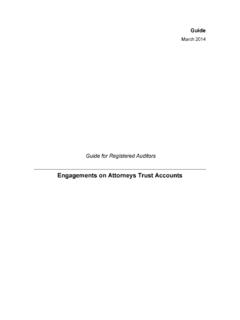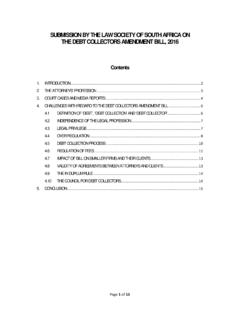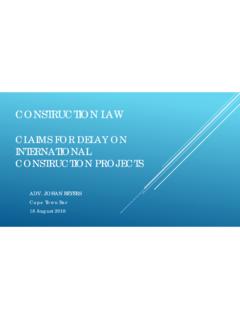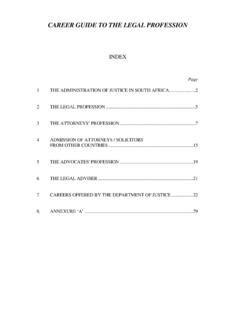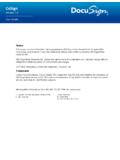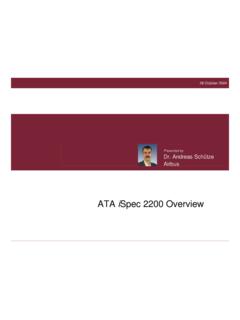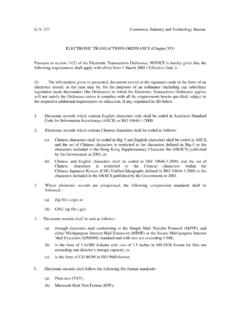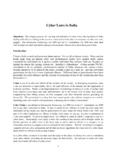Transcription of Electronic Signatures for South African Law Firms
1 Drafted for the Law Society of South Africa by Mark Heyink Electronic Signatures for South African Law Firms Guidelines: October 2014 Law Society of South Africa 2014 Graphic: Thinkstock Mark Heyink 2014 Electronic Signatures for South African Law Firms LSSA Guidelines VERSION Attorney, Notary & Conveyancer Specialising in Information Law Electronic Signatures Guideline 2014 eelleeccttrroonniicc ssiiggnnaattuurreess gguuiiddeelliinnee 114411001177 1 3 3 Chapter 4 1. Introduction .. 4 Chapter 6 2. THE FUNCTIONS OF signature .. 6 Primary Function ..6 Secondary F unction ..6 The American Bar Association ..6 Uncitral Model Law on Electronic signature s ..7 Reliance on Signatures ..7 Chapter 9 3. FORM OF signature .. 9 Manuscript Exceptions in the ECT Act ..11 Chapter 12 4. FUNCTIONAL EQUIVALENCE .. 12 In Uncitral Model Law on Electronic signature s.
2 12 American Bar Association Guideline to Digital Signatures ..13 Chapter 15 5. EL ECTRONIC SI GNATURES .. 15 In Electronic signature ..15 Id entity ..16 Intent to Sign ..17 Adoption of the Contents of Information Conclusion ..18 Chapter 19 6. digital Signatures .. 19 In American Bar Uncitral Model Law on Electronic Signatures ..20 How Do Digital Si gnatures Work ..20 Hash F unction ..20 The A pplication of Digital Signatures ..20 Chapter 22 7. advanced Electronic sig natures .. 22 In Definitions ..22 Accreditation ..23 Criteria for Electronic Signatures Guideline 2014 eelleeccttrroonniicc ssiiggnnaattuurreess gguuiiddeelliinnee 114411001177 2 Criteria for Qualifi ed Certificates ..24 Accreditation Regulations ..26 SANS21188-2006 (Public K ey Infrastructure fo r Financial Services Practices and Policy Framework) ..26 Face to Face Identification ..27 Revi ew of the L aw ..27 Chapter 28 8. THE IMPORTANCE OF Electronic SI GNATURES FOR ATTORNEYS IN South AFRICA.
3 28 In The LSSA s Initiatives ..28 Laws and Rules ..29 Registration Authority ..29 Security ..29 Conclusion ..29 Chapter 31 9. REFERENCES .. 31 Electronic Signatures Guideline 2014 eelleeccttrroonniicc ssiiggnnaattuurreess gguuiiddeelliinnee 114411001177 3 Foreword Please read this foreword carefully. This guideline has been compiled for the Law Society of South Africa pri marily as a tool to assist a ttorneys in familiarising themselves with the understanding of Electronic sig natures. This guideli ne is not intended and must not be construed as establishing any legal obligation. Neither is the guideline intended, nor must it be c onstrued, as providing legal advice. Signatures are intuitively understood by lawyers and lay pers ons alike. Their functions have become well established in commerci al practice and it is extremely infrequently that, aside from questions of fraud, issues relating to Signatures have to be d ecided upon in legal proceedings.
4 Electronic Signatures and manuscript Signatures differ consi derably in form and manner of application. This Guideline addresses the di fference in form between manuscript and Electronic Signatures and how in functions that are the equival ent of those inherent in manuscript Signatures may be establis hed by usin g Electronic Signatures properl y. Copyright Copyright in this material vests in Mark Heyink. The materi al may be used by the Law Society of South Africa under a li cence granted by Mark Heyink. Electronic Signatures Guideline 2014 eelleeccttrroonniicc ssiiggnnaattuurreess gguuiiddeelliinnee 114411001177 4 Chapter 1 1. INTRODUCTION The use of Signatures is ubiquitous and prevalent in our modern life in a myriad of ways. What i s interesting is that in the author s lecturing on the subject, when attendees are asked how many times they may have signed their name during a particular day, almost without fail the answer is with reference only to manuscript Signatures .
5 This, d espite the fact that many of them will have initiated tens and in some cases hundreds of Electronic communications over the same period. In many very in stances these communications will have been signed by the author or originator of the communication. Signatures have been part of our written communications over thousands of years. As a consequence manuscript Signatures are universally understood both in business and from a legal perspective and the need to define the meaning and functions of signature and its l egal implications has been limited. The advent of Electronic communications, in which the use of manuscript Signatures is redundant, has made it necessary to reconsider the nature and functions of Electronic Signatures in their various forms. In view of the considerable predominance of written communications being Electronic and the importance o f Signatures in our communications, we need t o re-examine how the functions of Electronic Signatures mirro r the functions of manuscript Signatures .
6 The author s e xperience is that there is widespr ead i gnorance of the implications of use of Electronic Signatures , the different forms of Electronic Signatures and how they ensure the r eliability of the signature itself and the integrity of Electronic information signed by way of an Electronic signature . Unfortunately, this ignorance is not confined to lay people and there are very few attorneys properly equi pped to d eal with the issues arising from the use of Electronic Signatures in their different forms. This paper seeks to pr ovide an understa nding of: the function of Signatures , whether manuscript or Electronic ; how Electronic Signatures in their d ifferent forms may provide functional equivalence (and are in certain cases superior) to manuscript Signatures ; how digital Signatures work; and the evidential implications of the use of Electronic Signatures . This Guideline also seeks to remove the confusion that h as been created b y the d rafters o f the Electronic Communications and Transactions Act ( the Act ) in their failure to follow international principles d efining Electronic Signatures and also to highlight the consequence of this failure.
7 In doing so it is hoped that the Guideline will assist attorneys in u ndersta nding the very different a pproach taken by the d rafters o f the Act to the international principles and practices governing the u se o f Electronic Signatures . Finally, this Guideline will deal with the importance of Electronic Signatures to members of the legal professio n; in protecting the confidentiality of communications, as we are bound by the rules of our profession to do; and Electronic Signatures Guideline 2014 eelleeccttrroonniicc ssiiggnnaattuurreess gguuiiddeelliinnee 114411001177 5 the profession s prospective dependency on informatio n systems requiring the authentication of the id entity o f originators of communications (for instance eServ ice and eFiling in our courts, e-Cadastre, Electronic deeds regis tration systems and other Electronic c ommunications with government and private institutions where the signature of attorneys, conveyancers and notaries may be r equired).
8 It is stressed that in dealing with Electronic Signatures the issue of information security and how it applies to the u se of Electronic Signatures is of fundamental importance. To that degree the Guideline on Information Security for South African L aw Firms published by the LSSA is supplementary to this Guideline. Electronic Signatures Guideline 2014 eelleeccttrroonniicc ssiiggnnaattuurreess gguuiiddeelliinnee 114411001177 6 Chapter 2 2. THE FUNCTIONS OF signature The aim of this chapter is to assist the reader in understanding: The p rimary f unctions of a signature , which include evidencing the: o Id entity of the signatory; o Intention of the signatory to sign; and o Adoption of the writing signed by the signatory. Primary Function Professor Chris Reed, the Head of the Information Technology Law Unit - Queen Mary & Westville College, London, in an article entitled What is a signature , identifies three primary f unctions of a signature recognised in c ommercial practice and in English law.
9 Professor Reed concludes that Englis h courts are prepared, at least in the case of hard copy documents, to accept Signatures made in any manner that provide evidence of: The identity of the signatory; That the signatory intended a signature to be his o r her signature ; and That the writing o r text to which the signature is associated is adopted o r a pproved b y the signatory. It is submitted that the same principles apply to the use of manuscript Signatures in South African law. Secondary Function In a ddition to the primary f unctions, Professor Reed also notes that there are secondary functions of Signatures , which include the validation of some forms of administrative action and the protection of consumers. These issues are dealt with later. The American Bar Associati on The American Bar Association ( ABA ) in its Guideline to Digital Signatures states: A signature is n ot part of the substance of a transaction but rather of its r epresentation or form.
10 Si gning writings serve the following general purposes: Evidence a signature a uthenticates a writing by identifying the signer with a signed document. When the signer makes a mark in a distinctive manner, the writing becomes attributable to the signer; Ceremony The act of signing a document calls to the signer s attention the legal significance of the signer s acts and thereby helps to prevent inconsiderate engagements. Electronic Signatures Guideline 2014 eelleeccttrroonniicc ssiiggnnaattuurreess gguuiiddeelliinnee 114411001177 7 Approval Approval, in certain contexts defined b y law o r custo m b y way o f signature , expresses the signer s approval or authorisation of the writing, or the signer s intention that i t has legal effect. While the wording d iffers, what is immediately evident is that the f unctions contemplated b y Professo r Reed and the purposes stipulated in the ABAs Digital S ignature Guidelines correlate closely.
